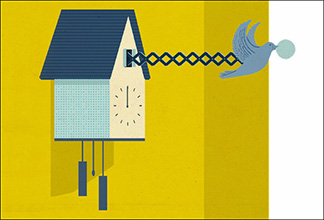The Lipstick Index and Other Weird Economic Indicators
Written by The Inspired Investor Team
Published on November 13, 2025
minute read
Share:
It can be hard to know when you’re in the midst of a recession – technically defined as two consecutive quarters of negative GDP growth – since you typically only learn of a month’s economic results after that month has ended. Since GDP estimates tend to take close to two months to be released, economists and investors sometimes prefer to look at more timely indicators like unemployment, manufacturing output, wage growth or consumer prices to help them determine what’s happening now and what may come next.
While investors may want to consider those same factors, there are other unofficial trends that could indicate the health of the economy. While some of these indicators are a bit unusual, they can make economic forecasting a little more fun.
The Lipstick Index
One way to predict whether an official recession may be on the horizon is to look at lipstick sales. You read that right. People tend to shell out on makeup, such as lipstick, when economic headwinds are ahead. That is, at least, according to Leonard Lauder,1 the late executive of cosmetics conglomerate Estée Lauder Companies. Lauder coined the term “lipstick index” in 2001 when he noticed that sales of lipsticks increased in the recession that followed the 9/11 attacks. He observed that during downturns, people tend to indulge in smaller, cheaper luxuries — like a tube of bright red lipstick or jet black mascara — over bigger-ticket items.2 Lipstick sales surged again during the Great Recession of 2008-2009, though they fell across Canada during the pandemic-induced recession,3 perhaps because people weren’t leaving their homes.
The Hemline Index
Another clue as to whether a recession is on the horizon? The length of skirts on store racks. The Hemline Index, which is often credited to 20th-century economist George Taylor,4 suggests that skirt lengths move in tandem with stocks. The idea is that women tend to be bolder with their fashion choices during boom times, reflecting growing confidence in the economy. In the 1920s, for instance, hemlines shortened as stock prices rose, before lengthening during the Great Depression.5 However, economists would later find that hemline lengths tend to lag behind the economy by about three to four years.6 Still, years later, some people look to skirt lengths as an unofficial, and fun, barometer for the health of the economy.
Buttered Popcorn Index
One silver lining of the Great Recession was that film studios reaped record sales from theatre-goers who watched movies like Paul Blart: Mall Cop7 and Bride Wars8 to escape — even temporarily — the emotional toll of financial hardship. The U.S. box office posted its first billion-dollar year during the 2009 recession,9 before sales eased in the years that followed. The buttered popcorn index suggests that more people attend films during tough economic times. There was an uptick in movie theatre attendance during the 1973-74 bear market10 and later in the 1981-82 economic downturn. The idea here is that while movies and snacks may not be cheap, this form of entertainment can be more affordable than a vacation, a pricey concert or even a night out for dinner and cocktails.
Men’s Underwear Index
Former U.S. Federal Reserve Chairman Alan Greenspan popularized the men's underwear index. Stay with us here: The idea is that consumers shop for men’s underwear when the economy is humming along. But when there’s an economic downturn, people are more likely to consider undergarments a discretionary, rather than necessary, purchase, and they may choose to save money rather than purchase new ones. During the Great Recession, men’s underwear sales experienced a significant drop,11 reflecting a reduction in consumer spending amid financial uncertainty.
Sources
1. J.P. Morgan Wealth Management, "What is the Lipstick Index?", June 2025
2. CNN Business, "Is a recession coming? Economists say look at women's lips", June 2024
3. Statista, "Lip Cosmetics - Canada", 2025
4. Nasdaq, "What Is the Hemline Index, and Is It an Accurate Recession Indicator?", May 2025
5. InStyle, "Is the Hemline Index Actually Real?", September 2020
6. Heggie Investment Partners Raymond James, "In the 1920s, hemlines were thought to predict the economy", August 2022
7. The New Yorker, "Recession-Proof: Paul Blart Edition", January 2009
8. Rolling Stone, "Bride Wars", January 2009
9. The Guardian, "Moviegoers set US box office record in effort to escape recessionary gloom", February 2009
10. The New York Times, "Film Box-Office Receipts in '74 a Record $1.9 Billion", January 1975
11. Glenmont Consulting, "The Men's Underwear Index as an Economic Indicator", 2024
RBC Direct Investing Inc. and Royal Bank of Canada are separate corporate entities which are affiliated. RBC Direct Investing Inc. is a wholly owned subsidiary of Royal Bank of Canada and is a Member of the Canadian Investment Regulatory Organization and the Canadian Investor Protection Fund. Royal Bank of Canada and certain of its issuers are related to RBC Direct Investing Inc. RBC Direct Investing Inc. does not provide investment advice or recommendations regarding the purchase or sale of any securities. Investors are responsible for their own investment decisions. RBC Direct Investing is a business name used by RBC Direct Investing Inc. ® / ™ Trademark(s) of Royal Bank of Canada. RBC and Royal Bank are registered trademarks of Royal Bank of Canada. Used under licence.
© Royal Bank of Canada 2025.
Any information, opinions or views provided in this document, including hyperlinks to the RBC Direct Investing Inc. website or the websites of its affiliates or third parties, are for your general information only, and are not intended to provide legal, investment, financial, accounting, tax or other professional advice. While information presented is believed to be factual and current, its accuracy is not guaranteed and it should not be regarded as a complete analysis of the subjects discussed. All expressions of opinion reflect the judgment of the author(s) as of the date of publication and are subject to change. No endorsement of any third parties or their advice, opinions, information, products or services is expressly given or implied by RBC Direct Investing Inc. or its affiliates. You should consult with your advisor before taking any action based upon the information contained in this document.
Furthermore, the products, services and securities referred to in this publication are only available in Canada and other jurisdictions where they may be legally offered for sale. Information available on the RBC Direct Investing website is intended for access by residents of Canada only, and should not be accessed from any jurisdiction outside Canada.
Explore More

How Your Portfolio Could Be Like a Playlist
Building a diversified portfolio may not be different from putting together a multi-genre playlist
minute read

The 5 a.m. Investor: Morning Routines That Build Wealth
When it comes to building wealth, the early bird really can get the worm
minute read

Getting Stock Tips From Your Group Chat? Here’s How to Know Which Ones are Worth Exploring
When one of your pals shares a tip in the chat, you might feel inclined to act on it, but should you?
minute read
Inspired Investor brings you personal stories, timely information and expert insights to empower your investment decisions. Visit About Us to find out more.







